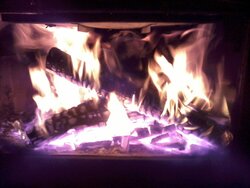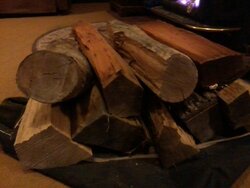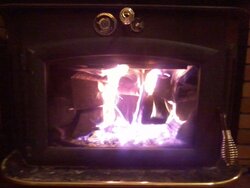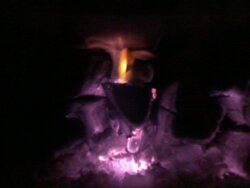I look at it this way; At least we're smart enough to
realize we're morons. Many don't.

Thanks for the kind words. I guess once in a while I make sense. Sometimes I look at what I've written and say to myself "That's not very concise, it's a rambling wreck."

it is o.k., once the cat reaches a good temp, that the flame goes out and the hot glowing splits continue to glow, to use that for heat. I was always thinking that I need some kind of flame....the lack of secondaries had me confused.
Right. Secondary burn in a tube stove is accomplished by supplying heated combustion air through the tubes at the top of the fire box and burning the smoke there. Our main "secondary burn" is the cat burning the smoke. And as a bonus, sometimes the logs won't be flaming but the smoke from them will ignite underneath the cat shield where it is hot and there's oxygen available from the air wash. That's essentially the same as what happens in a tube stove. So we've got a "triple burn"...log flame, cat glow, and floater "secondary" flame.

I was concerned about a chimney fire, but he said with this stove and the S.S. liner it would not be a problem.
Well, you
could have a chimney fire in the liner but normally with hot start-up fires and the cat eating the smoke when you've got the air cut to cruise, the chimney won't quickly accumulate creosote. Now, if the cat crashes (falls below the temp necessary to maintain combustion within the cat,) then deposits will occur at a faster rate. At any rate, everyone's setup is different and it's wise to check your flue every few weeks with a new stove, until you have an idea how fast creosote is going to accumulate. A number of factors contribute to how much creosote your flue will accumulate; How dry your wood is, how fast gasses cool in your stack, etc.
The only problem with running the cat at 1800 for a while would be that I would ruin the cat
Yes, wash coat containing the catalyst metals can separate from the substrate (ceramic or steel.) I feel that the lower I can run the cat while still keeping it active, while still providing the necessary heat, the better. I like to see it at 1300-1500, I figure it's not working as hard then. Of course, the cat can be burning smoke, but not glowing. When I loaded tonight, I saw the tin foil marker on the cat had moved up to 1800. I don't know how long it was that hot, since I wasn't there.

I know I could learn a lot if I were able to be there to observe complete burn cycles. I reset the tin foil to 1500 on every load, and have not seen it pushed up to 1800 for quite a while. I think I had more Cherry and Red Elm in that load, and it may have gassed off a little faster, resulting in the cat getting hot. The more dense woods like Oak and Hickory seem to gas is a slower, more controlled fashion.
But back to the full loads, load 'er full during the day for a while, when you can watch the entire burn. Once you feel comfortable that you pretty much know what's gonna happen, then you'll feel OK loading it up for overnight burns. There are a lot of factors determining how a load will burn; Split size, type of wood, colder weather (creates more draft) and so on. With experience you'll be able to factor in the variables and predict (usually) how a given load will burn.



 I wondered why I got like 2.5 gallons of creo outta the stack a few days ago, when it's only been a few months of burning. Burning up all my hard work getting the wood for her, and not getting the heat from it, just gunking the chimney. Sheesh.
I wondered why I got like 2.5 gallons of creo outta the stack a few days ago, when it's only been a few months of burning. Burning up all my hard work getting the wood for her, and not getting the heat from it, just gunking the chimney. Sheesh. Thanks for the kind words. I guess once in a while I make sense. Sometimes I look at what I've written and say to myself "That's not very concise, it's a rambling wreck."
Thanks for the kind words. I guess once in a while I make sense. Sometimes I look at what I've written and say to myself "That's not very concise, it's a rambling wreck." 
 I know I could learn a lot if I were able to be there to observe complete burn cycles. I reset the tin foil to 1500 on every load, and have not seen it pushed up to 1800 for quite a while. I think I had more Cherry and Red Elm in that load, and it may have gassed off a little faster, resulting in the cat getting hot. The more dense woods like Oak and Hickory seem to gas is a slower, more controlled fashion.
I know I could learn a lot if I were able to be there to observe complete burn cycles. I reset the tin foil to 1500 on every load, and have not seen it pushed up to 1800 for quite a while. I think I had more Cherry and Red Elm in that load, and it may have gassed off a little faster, resulting in the cat getting hot. The more dense woods like Oak and Hickory seem to gas is a slower, more controlled fashion. Probe was down about 500. I didn't want to load on the fly and burn up too much of the load getting to 700, where I usually close the bypass, so I pulled the coals forward and tossed in a couple small splits to heat up the stove. Staged load has 2 Cherry and 2 Red Elm on top, which I stacked against the left and right walls to hopefully speed up the burn at the end, keep stove temp up, and not leave a lot of coals. The rest of the load was some White Ash and White Oak and that filled up the center. I didn't load full...don't want much left when I come back in 12 hrs. A full load of Oak could go 16 hrs, I'm pretty sure, and if I were there to open the air a little at the end, stove would probably still be hot enough to load on the fly. I try to leave some space between splits in the center so that flame can get to the top of the fire box and heat up the stove faster. The last pic is after the bypass is closed, stove is about 400, probe about 1200, and a little flame is popping up once in a while on top of the center split.
Probe was down about 500. I didn't want to load on the fly and burn up too much of the load getting to 700, where I usually close the bypass, so I pulled the coals forward and tossed in a couple small splits to heat up the stove. Staged load has 2 Cherry and 2 Red Elm on top, which I stacked against the left and right walls to hopefully speed up the burn at the end, keep stove temp up, and not leave a lot of coals. The rest of the load was some White Ash and White Oak and that filled up the center. I didn't load full...don't want much left when I come back in 12 hrs. A full load of Oak could go 16 hrs, I'm pretty sure, and if I were there to open the air a little at the end, stove would probably still be hot enough to load on the fly. I try to leave some space between splits in the center so that flame can get to the top of the fire box and heat up the stove faster. The last pic is after the bypass is closed, stove is about 400, probe about 1200, and a little flame is popping up once in a while on top of the center split.



 Just trying to help out, like everyone did me when I first came here. I was trying to burn dead Red Oak, but it had only been split for 6 months, max. I thought "Heck, the tree was dead so it must be ready to burn." These guys clued me in that Oak takes more time to dry than just about any other wood, and now I have that Red Oak split and stacked for 3 years before I have to burn it. In your case, I would stack next year's wood single-row, out in the wind, top-covered, and don't split it too big. Maple (especially soft Maple) and Elm should be at least decent in the fall. Of course, those smaller splits will burn and gas off a bit faster and you'll have to factor that in when starting your loads and setting the air. Most folks dry their wood out in the wind, then when it's ready to burn, stock their shed for the following season. Makes sense, since the air movement through tightly-packed wood in the shed is not as good. Now if you can let that freshly-split wood sit in the shed for several years, that's a different story. I'm no spring chicken either, but I'm learning more every day about this art of burning wood.
Just trying to help out, like everyone did me when I first came here. I was trying to burn dead Red Oak, but it had only been split for 6 months, max. I thought "Heck, the tree was dead so it must be ready to burn." These guys clued me in that Oak takes more time to dry than just about any other wood, and now I have that Red Oak split and stacked for 3 years before I have to burn it. In your case, I would stack next year's wood single-row, out in the wind, top-covered, and don't split it too big. Maple (especially soft Maple) and Elm should be at least decent in the fall. Of course, those smaller splits will burn and gas off a bit faster and you'll have to factor that in when starting your loads and setting the air. Most folks dry their wood out in the wind, then when it's ready to burn, stock their shed for the following season. Makes sense, since the air movement through tightly-packed wood in the shed is not as good. Now if you can let that freshly-split wood sit in the shed for several years, that's a different story. I'm no spring chicken either, but I'm learning more every day about this art of burning wood. 